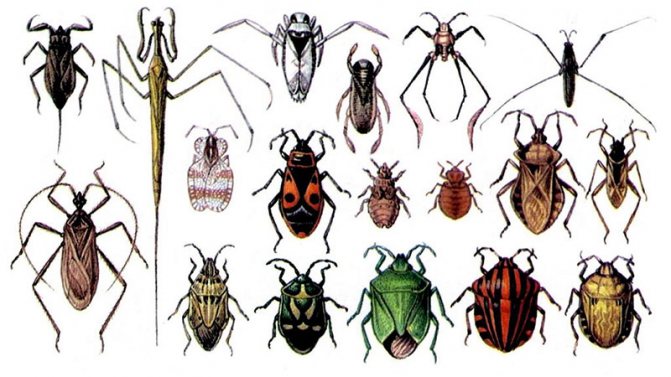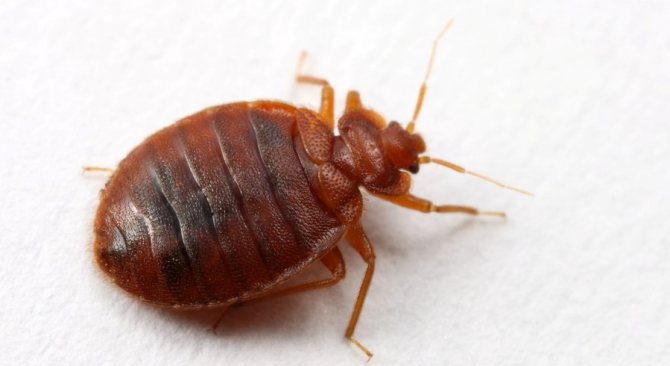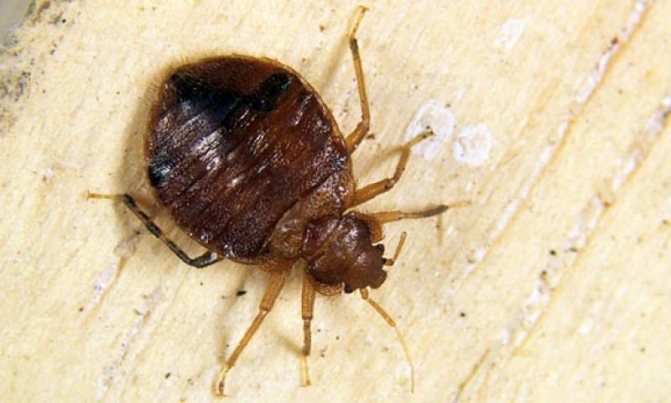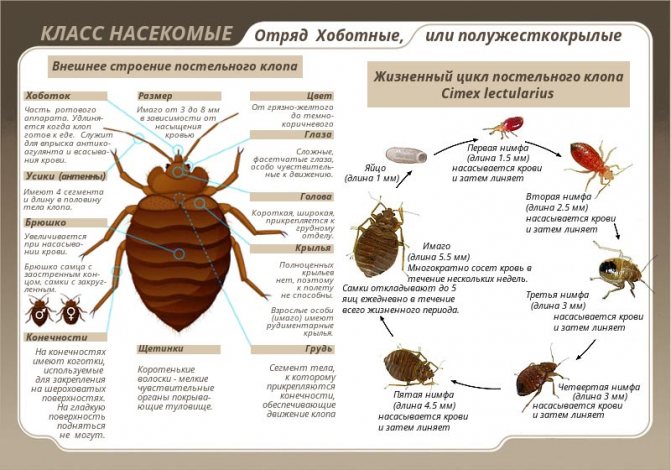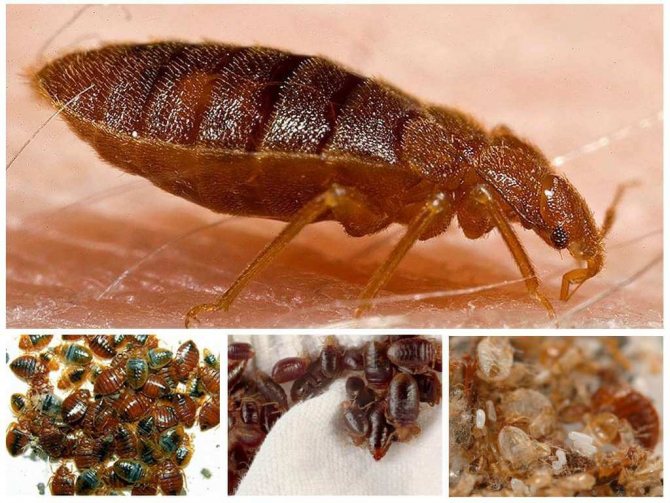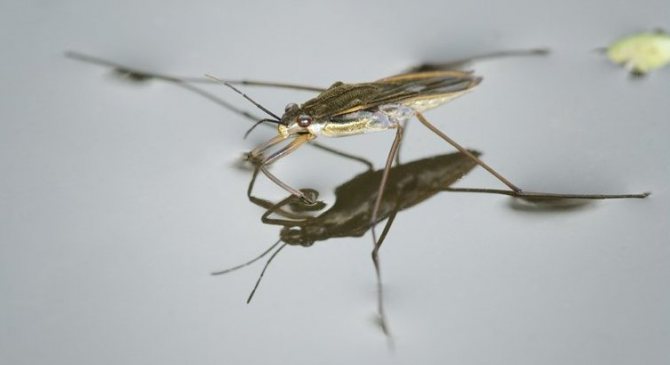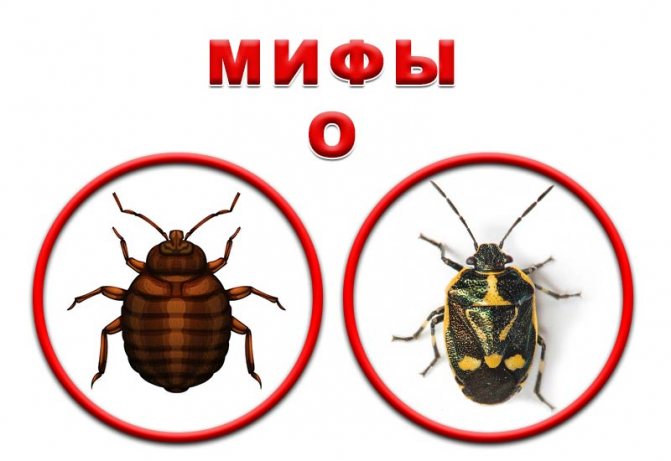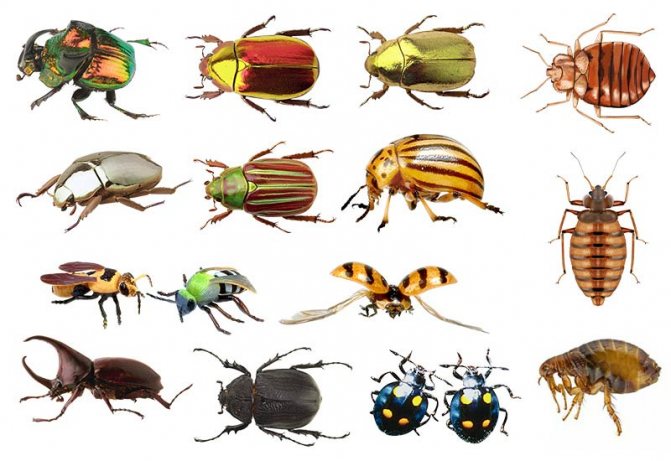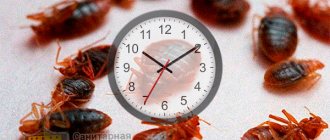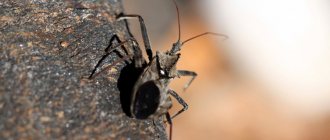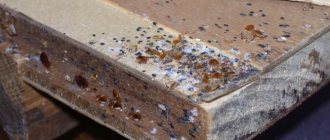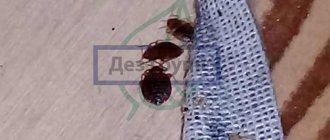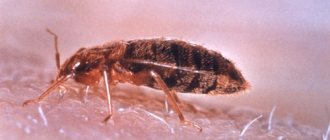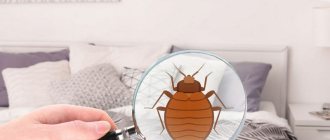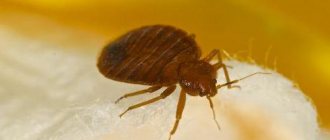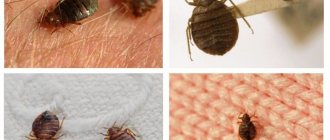Bed bugs are domestic pests that live near a person and feed on his blood. Almost everyone knows about their existence, but not everyone can imagine what an insect looks like. And once having met a parasite in their apartment, some residents of the metropolis simply do not recognize a bloodsucker in him. There are many myths about Hemiptera based on erroneous information. So according to one of them, parasites are able to fly and even jump. Well, in reality, bugs jump or crawl, this article will tell.
Wild flying
Bedbug populations are numerous. Among tens of thousands of species, some are able to fly. They have a well-developed pair of true wings, due to which they move through the air.
Flying bugs:
- Triatom is a representative of the Hemiptera. Individuals are dangerous to humans. The bite can contract the deadly Chagas disease. They live in America. In Russia, there are single specimens. A tropical insect has a pair of wings. Predators settle next to human habitation: in sheds, in attics, in yard buildings. With the onset of darkness, they fly closer to the victim, which is people. The bug feeds on blood.
- Marble pest of crops. Spotted in Asia. Destroys melons, berries, loves vineyards, nightshades. You need wings to travel long distances.
- The water flying bug is a black insect, reaching 3-4 cm in length. It has smooth rigid elytra. The bite is not dangerous to humans, but the pain is comparable to a wasp sting. Pest control is useless, as families fly over the pond very quickly.
- Rod water strider. It has a laterally flattened abdomen and long legs. From the moment the nymph turns into an imago, the bug can fly. After wintering, this ability of the water strider passes. The muscles responsible for the movement of the wings atrophy, are digested during hibernation and are used as additional food.
- Turtle. A small brown bug pest on farmland. Outwardly it resembles a small turtle.
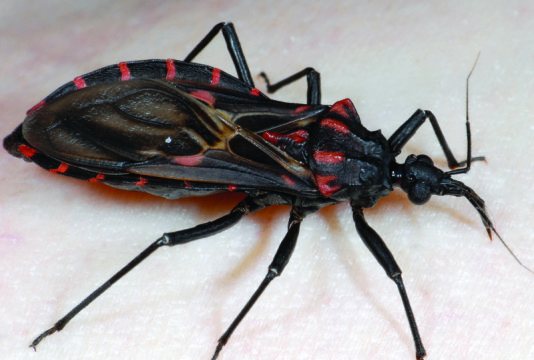
Triatomic
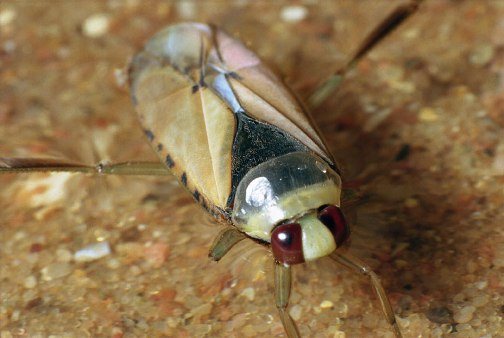

Gladysh
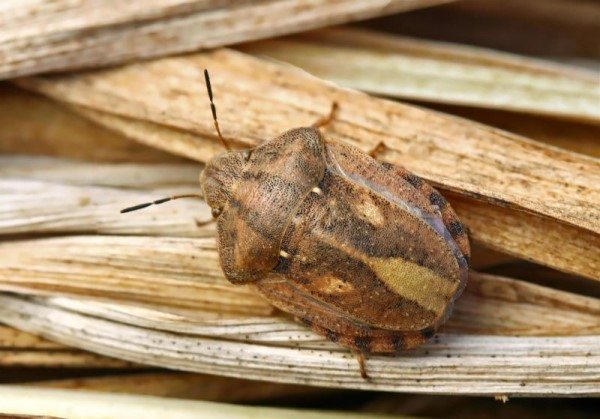

Turtle
There are more flying bugs than those without wings. They are not dangerous for a person. Harmfulness consists in eating vegetation. If you catch a bug, you can "get in the nose", since all flying and flightless insects exude an unpleasant odor to scare off the enemy.
Important! If adults are equipped with a flying machine, their larvae do not have wings. Over time, it is noticeable how the elytra begin to form in the nymphs.
If you spot a flying guest, don't worry. This is a street insect that has flown through an open window. Entomologists say that insects need wings to move from one territory to another in search of food, from danger, for resettlement. Their flight is short, since the wing muscles are rather weak.
Flying representatives of the detachment look larger than crawling ones. Most often, you can meet with them in the fall, when, with the onset of cold weather, they fly to apartments in search of food and shelter from the cold. In private houses, the likelihood of such a meeting is higher than in high-rise buildings. Street insects fly to where there is a lot of delicious greenery.
The relationship between insects
The house bug is a small individual, the body of which has a flattened shape.The body is from 2 mm to 8 mm long. After feeding, the size of the bug increases in proportion to the blood consumed.
The parasite is brown or black in color. After eating, it takes on a scarlet or burgundy hue. There is a sting for piercing the skin and sucking out blood. How a bug bites is not felt by a person or an animal due to a special substance that is produced by the gland of the bloodsucker.
House bugs
The insect has a standard set of legs in the amount of 3 pairs. Their structure allows the bloodsucker to move quickly, and the flat body makes it possible to get into the narrowest cracks. This ability quickly disappears after the bed bug takes food. A well-fed individual is passive, moves very slowly and reluctantly.
The relationship between bloodsucker bugs and other insects that live in apartments is very complex. Due to the constant bites on the body, a person often resorts to the fight against bloodsuckers. While it can live with ants and cockroaches for a long time. Also insects become dangerous to each other. What can happen between parasites:
- Cockroaches are happy to feast on bed bug eggs. Regardless of the fact that the habitats of these pests are different, cockroach larvae are able to penetrate into the shelters of bloodsuckers and ruin their clutches.
- The poisonous glands of ants are fatal to the bug. Purposefully, they do not fight among themselves, however, parasites cannot settle nearby. In addition, adult ants are also not averse to feasting on beetle larvae.
- Centipedes are happy to catch and kill even adult bloodsuckers. However, the centipede itself is a rare occurrence in human housing.
Bedbugs themselves cannot harm anyone other than humans. Interestingly! Cats hunt for any insects that move around the rooms, but do not pay attention to bugs at all. Perhaps this is due to the specific smell of the parasite.
Bed bugs that don't fly
Many forest creatures cannot fly, although the outlines of wings are clearly visible on the back. These are modified rigid elytra that do not move and can be called a pattern. Toy soldiers, water striders.
Home
A forest bed bug living next to a person does not fly. It has no elytra, only the head, abdomen, and legs.
Interesting! For a long time, the bed bug parasitized on bats, it had wings. The host was used for long distance flights. In the course of evolution, the wings disappeared.
The bed (linen) bug moves around the apartment on small legs. The body is flat. It is difficult to crush it, to catch it. He is nimble, crawls along walls, ceilings, settles in furniture accessories, closer to a person. Families can be found on the couch, mattresses, on wooden bed structures. The bed does not need wings, its speed is two meters per minute, which is fast for an insect.
It is easy to find a bloodsucker in an apartment, along the characteristic red paths on the skin. The insect pierces the human dermis in search of a good place to feed, moving upward. Another option for detecting bed bloodsuckers is an unpleasant odor exuded by a specific gland. They say that "the apartment smells of bedbugs."
They operate at night when the owners are asleep. They crawl onto the sleeping person's body and, biting through the skin, suck blood. When piercing the skin, the parasite lets in an anesthetic, so the person does not feel pain. At one time, the bug is able to drink blood three times its mass. You can get bitten up to 500 times a night if the house is swarming with pests.
White
Crawling bugs include whites, whose wings are missing. They do not even have rudiments similar to the elytra. They are rare, they prefer to live next to a person. Very small, transparent. On the head they have outgrowths similar to hairs. They are residents of rural houses.They feed on human blood.
Chimney or swallow
Chimney bugs (swallow) belong to blood-sucking bugs. They live in floor crevices, chimneys, in attics. The wings have been absent since the birth of the species. They don't need to fly because food lives in the neighborhood. They feed on bird and human blood.
Penetration into the apartment
Bedbugs settle in an active and passive way. When active, the parasite colony migrates locally. At first, they start up in the mattress, then they spread throughout the room, gradually filling the adjacent rooms. Through risers, sockets, landings they move to neighbors. With passive resettlement, they go to other countries, hiding in bags, suitcases, clothes. With upholstered furniture they move to neighboring houses and districts.
Reasons for active resettlement
Bed bugs do not change their habitat unnecessarily, especially if they have enough food. The main factors contributing to active settlement:
- Home processing. Blood sucking will not die if the house is treated with a mild aerosol. Feeling threatened, they will leave their hideout in search of a safe place. Most of them run over to their neighbors. In good weather, they climb out through holes in balcony frames or windows, then crawl up the walls. They also run away through ventilation or communications.
- Colony enlargement. Often, bedbugs start in dysfunctional families that consume alcohol. Such tenants do not carry out disinsection, and after 1-2 years the apartment is teeming with parasites. Gradually, the focus of infection moves into the entrance, endangering all nearby apartments. Furniture items picked up from landfills also become sources of contamination.
- Repairs. Bedbugs get out of their hiding places and spread throughout the house during construction and repair work. They are frightened by the noise and vibration generated in the walls from construction tools.
Passive migration factors
By their nature, bed bugs are unable to migrate long distances on their own. Their movement across other countries and continents occurs through human activities. Two main ways of passive migration of parasites have been established:
- On a person. The economy is constantly developing, thanks to this, new trade relations are concluded between different countries. Travel has become available for people with different financial situations. Because of this, many different guests pass through the hotels. Budget hotels and hostels are especially dangerous. After spending the night with bedbugs, there is a high chance of bringing them with you. Parasites easily sneak into the bags and suitcases of guests. Some people do not suspect that bedbugs are in the house and do not comply with quarantine, so bloodsuckers can be brought from the guests.
- With objects. With the development of the Internet, the volume of trade has grown and expanded significantly. The purchased goods are brought directly to your home. Infection with parasites occurs through second-hand stores, purchases of used goods (old furniture, appliances, clothing). In order not to throw away the contaminated sofa, some people choose to sell it.
Important! There have been many reported cases of transmission of bedbugs through new furniture. Warehouse staff often bring parasites from their homes. Therefore, when purchasing furniture products in stores, you must carefully examine them for bedbugs.
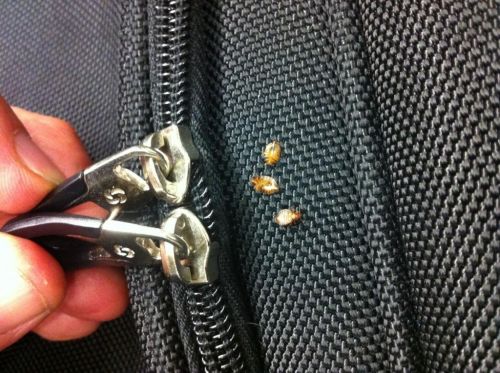

Jumping bugs
Not all bugs crawl and fly. There are representatives who jump. Their jump is like flying.
- Some species of water striders have wings, but they are underdeveloped and can unfold for a few seconds. This is enough to make a jump for the victim.
- The flightless include coastal (coastal bald). The jump sometimes lasts a minute. For people, they are quite safe, they feed on insects smaller than themselves.
- Shitnikov, kraeviks - live in green gardens, parks, forests. They jump on a person, but do no harm.For relocation over long distances, existing wings are used.
Interesting! All jumping and flying bugs living on the street are camouflaged. Various shades of green, black, brown. Drawings and patterns are depicted on the rigid wings. This feature saves from the enemy. A green berry bug that lives in raspberries. It is difficult to notice, and when picking or while eating the berry, the presence is palpable. Once in the hands, it releases an odorous liquid.
Bloodsucker lifestyle
The bed bug spends most of its time in hibernation. The greatest activity is observed in the period from 3 am to 6 am. At this time, the victim is fast asleep and will not be able to interfere with food intake. Hungry, they go hunting. In most cases, the parasite prefers to settle as close as possible to humans in order to have quick and direct access to the food item. Once full, the individual very slowly returns to the nest.
We suggest that you familiarize yourself with: What do bed bugs eat
Experts say that the sense of smell is the most developed organ of a nocturnal guest. Thanks to him, he can smell a person even several meters away. A bed bug will quickly detect a person by the carbon dioxide released during respiration. The bloodsucker is able to catch the smell of sweat even from tens of meters away.
How to deal with flying and flightless bed bugs
The development of wings in insects depends on the lifestyle. If the bug feeds on the foliage of plants, trees, it needs to fly long distances. No wings are needed near the victim. Depending on whether the pests are flying or crawling, you can choose an effective method of control. For those flying, you will need traps, special scarers. Crawling individuals hide and it is harder to catch them with such methods. Other means of pest control are used to catch.
There is a fierce struggle against pests of farmland, berry fields and domestic representatives. In case of mass defeat, they resort to the help of special services. At home, they use improvised means: sticky traps, tapes, sweet food, homemade traps from plastic bottles.
Single flying bugs do not pose a threat, there is no point in fighting them. If a flying squirrel is found in the apartment, it is better to catch it with a matchbox and let it out into the street.
Interesting! In Altai, an invasion of forest bugs was recorded, massively migrating from forests to cities. This is due to a cold snap, late blooming of trees, in connection with which there was a hunger strike. The pest control services fought the invasion: they treated park areas, walls of houses. People cleaned their loggias on their own. There is no harm from flying insects to people, houseplants can suffer, as the green forest bug feeds on plant sap.
So that the uninvited guest does not disturb again, install mosquito nets on the windows, spread rags soaked in vinegar on the windowsills, seal the window and balcony cracks on the street side with sealant. If the bugs are still there, use insecticides.
The reproduction process of the parasite
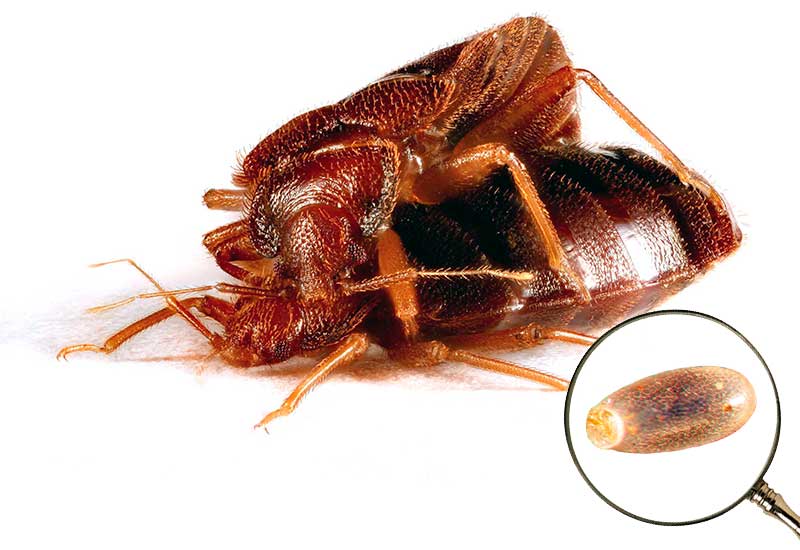

Bed bugs reproduce much faster than other insects. They become sexually mature pests already 30 days after emergence from the egg. The speed of development can only be affected by the temperature in the room. Larvae grow more slowly at low temperatures. One female, in her entire adult life, is capable of laying up to 400 eggs.
The mating process takes place in a traumatic manner. Males pierce the female's body and inject sperm into the abdominal cavity. After such contact, the female carries a seed for a long time and lays 5-6 eggs daily. If the mother does not receive blood for a long time, her body begins to absorb the larvae that are not yet developed inside.

